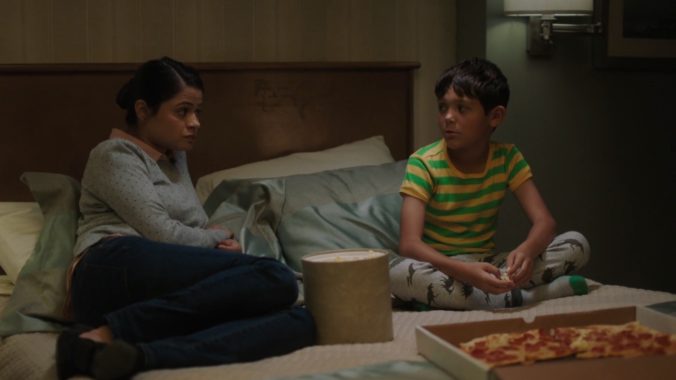The people change, but the hotel room always stays the same.
Fresh towels, a well-made bed, a phone. Tables with nothing on them. Think of the things a hotel room could see. A babysitter watching a kid. A married couple ordering a pizza. A cult ceremony. Anything can happen in a hotel room.
That’s what Jay and Mark Duplass explore in their new HBO anthology series, “Room 104.” Each episode (three have aired) tells a different story in the same hotel room. Everything happens in the confines of the room. The characters are new and different each time. The stories are simple in premise, and complicated in practice. And to this point, it has been absolutely compelling television.
There are a lot of television shows. You know that. I know that. But most of them follow a loose structure. There are characters we love, and they have a conflict they need to solve. We typically may not know exactly where every story is headed, but we have a sense of its general direction. The good guys are probably going to win, the bad guys are probably going to lose. Maybe a supporting player will die along the way.
The most gripping thing about “Room 104” is that it feels like truly anything can happen. With new people and limited information each time out, you never know where things are going or where they’re coming from. You’re just waiting in a hotel room, watching.
There’s something to be said for a show that makes your heart pound. I won’t pretend I totally understand the endings of the first three episodes of “Room 104,” but I don’t feel like it matters. The simple, economical shots that set up each episode have me hooked instantly. There’s something about the simple mundanity of the hotel room that gives it an eerie edge, something about its staidness that makes it feel like anything can happen. Everything appears controlled in a way that feels completely out of control.
So far, the show has been funny, scary, steamy, disturbing, beautiful and thrilling. The deft control of tone and easy shifts from drama to comedy and back and forth and all around, along with the brevity of the episodes, keeps you locked in. The camera – manned by Sarah Adina Smith twice and Patrick Brice once in the first three episodes –continues to find interesting and creative new ways to film people’s lives in the hotel room. The use of doors and colors and staging is fascinating. The simple, effective story set-ups leave room for all kinds of twists and turns.
The brilliant contradiction of “Room 104” is that it takes place in a tiny, confined space, but absolutely anything can happen.
The Duplasses have set out to “find some magic in the seemingly mundane.” And they’ve found much more than just magic. They’ve found life, death, love and many other confusing and beautiful things about our world. They’ve taken a room and welcomed in the whole world.
They don’t let us off the hook, though. You want to see what goes on behind closed doors? Fine, be a fly on the wall. You’ll see something you shouldn’t be seeing. You’ll realize that the simple act of watching makes normalcy seem strange. You’ll wonder what it would mean for someone to watch you.
There will be 12 episodes in the first season of “Room 104.” And I’m thrilled to explore them all. It can take us anywhere, and there are not a lot of shows with an element that exciting. I don’t know where it will take us, or what it will mean, or if I’ll even enjoy the ride. But the sheer thrill of not knowing where the ride will take us makes it worth the price of admission. Television needs more shows like “Room 104,” willing to try anything and everything to reinvent what it means to be telling stories in a small box, whether it’s the one in our pocket or the one in our living room.

I am going to make sure I watch it.